30+ SAMPLE Data Strategy Plan
-

Data Strategy Security Plan
download now -

Comprehensive Data Strategy Plan
download now -

Components of Data Strategy Plan
download now -

Federal Data Strategy Action Plan
download now -

Enterprise Data Strategy Plan
download now -

State Enterprise Data Strategy Plan
download now -
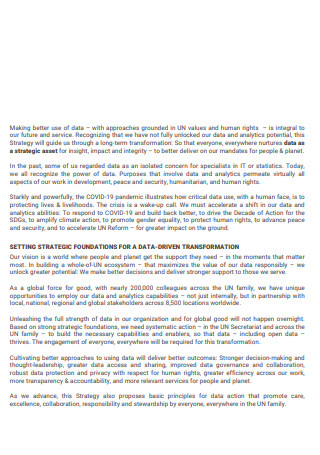
Secretary Data Strategy Plan
download now -

Education Data Strategy Plan
download now -

Commerce Data Strategy Plan
download now -

Elements of a Data Strategy Plan
download now -

Nonprofit Data Strategy Plan
download now -

Open Data Strategy Plan
download now -

Food Agency Data Strategy Plan
download now -
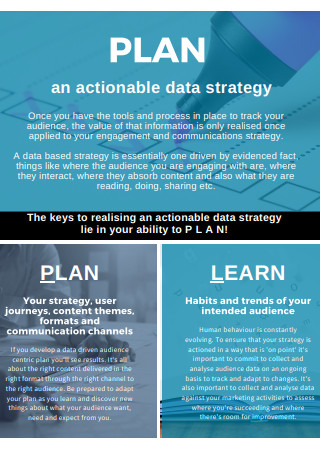
Actionable Data Strategy Plan
download now -

Energy Data Strategy Plan
download now -

Government Data Strategy Plan
download now -

Developing a Data Strategy Plan
download now -

Environmental Data Strategy Plan
download now -

Data Management Strategy Plan
download now -
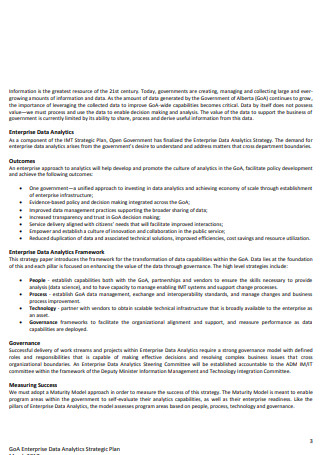
Enterprise Data Analytics Strategy Plan
download now -

Simple Data Strategy Action Plan
download now -
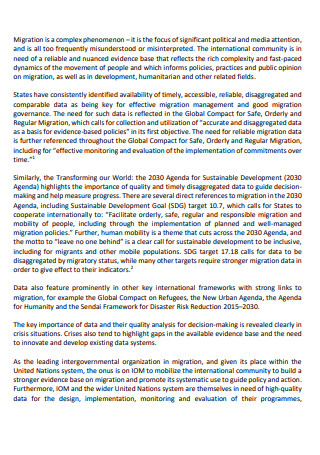
Migration Data Strategy Plan
download now -

Geospatial Data Strategy Plan
download now -

Learning Analytics Data Strategy Plan
download now -
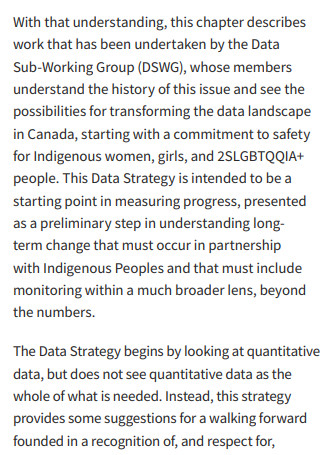
National Data Strategy Plan
download now -

Service Data Strategy Plan
download now -

Financial Data Strategy Plan
download now -

Standard Data Strategy Plan
download now -

National Open Research Data Strategy Plan
download now -

Data Research Strategy Plan
download now -

Data Science Strategy Plan
download now
What Is a Data Strategy Plan?
A data strategy plan contains an organization’s vision of the collection, storage, management, sharing, and utilization of data. The Massachusetts Institute of Technology, Center for Information Systems Research (MIT CISR) Data Board defines it as a central and integral concept that articulates the function of data to inspire business strategies. The data strategy plan of an organization will look different from one another, depending on the industry. However, these plans still perform accordingly. The plan must define how data contributes to business development, meet business objectives through different activities, describe possible changes to organizational needs to maximize the value of data activities, and outline other plans to apply these changes. The document must also establish a workable timeline to complete activities, define vital milestones and priorities, and describe necessary procedures to move work forward. The data strategy must also relay necessary financial justifications for the data activities and the benefits it brings to the company, using the information to increase business profitability and data monetization. Remember that the data strategy plan must follow the SMART methodology, making it specific and actionable yet open to revision and changes as circumstances can change.
According to an article from the Harvard Business Review entitled What’s Your Data Strategy, published in the magazine from May-June 2017, cross-industry investigations show an average of less than half of structured data from organizations actively make decisions for the company, with less than one percent of unstructured data analysis and use. Data also shows that 70 percent of employees have access to information they should not have access to, while 80 percent of the time spent on data analysis only involves identifying and preparing data.
Components of a Data Strategy Plan
Each company has varying levels of technical needs and analytical maturity. The crafting of data strategy plans greatly depends on the needs and development of an organization. Each of the following elements below is essential to creating a data strategy plan, regardless of the nature of a company. These components ensure that a data strategy plan helps the business to grow and mature while keeping information safe.
How To Create a Data Strategy Plan
Every stage of creating a data strategy plan must prioritize company goals. It must also discuss the intended data use, whether it is for advertising purposes, content personalization, or any other purposes. It helps develop strategies to drive processes. Below is a helpful guide that helps organizations create a data strategy plan to accomplish organizational goals.
-
1. Create a Proposal and Accumulate Buy-Ins
The first step in creating a data strategy plan is to develop a proposal and earn buy-in from stakeholders in the company. Target high-level executives to receive approval and resources to implement the plan. It is also advantageous to buy in stakeholders from different levels and departments to get their participation. Present a strategy that highlights the benefits the company receives to acquire buy-in from company leaders. You can also present information on competitors and how they manipulate data to their advantage while showing clear examples and data to back up these claims. Get all necessary stakeholders involved in the strategy to ensure maximum participation towards a successful data strategy. Be open to revising the proposal to gain more buy-ins.
-
2. Build Data Management Teams and Assign Their Respective Roles
After the proposal agreement, establish data management teams. The teams must consist of senior-level managers and department heads that have a background in data storage and management, including technological and organizational capabilities, opportunities, and limitations. Each team must have a variety of individuals that have different viewpoints. Conduct employee assessments to find the right individuals, and incorporate the help of external sources if there are missing aspects that you wish to address in data management. It is the responsibility of the teams to allocate resources, establish and improve policy and procedures, and deal with data issues. Aside from constructing teams, members must have data governance roles. It determines responsibilities for complying with standard operating procedures, deploying technologies, providing updates, and many more. These responsibilities ensure the accomplishment of tasks and the promotion of work ownership.
-
3. Identify Data Collection Procedures and Sources, Setting Goals for Collection and Distribution
The next step of the data strategy plan is to determine data sources and collection methods. Remember that data collection depends on the organizational goals. An organization must incorporate a SMART goal-setting process, establishing short-term and long-term goals, including overarching objectives. Elaborate on the role of data collection and distribution and its benefits to determine a suitable vision statement for data use in the coming years.
-
4. Create a Data Strategy Roadmap
After setting concrete goals, outline a comprehensive plan to achieve them. A roadmap comes from the collection of these plans. The programs must specify the individuals, processes, technologies, project costs, and period to accomplish each. These must also be flexible enough to make revisions and adjustments as necessary. As these plans move forward, the organization must provide evaluation processes to determine their effectiveness. The data strategy roadmap outlines the plan to accomplish short-term goals to achieve the company vision.
-
5. Data Storage and Organization Plan
Create policies that detail data storage and organization. These regulations determine the usability of acquired information. When creating storage methods, consider storage capacities and data sharing capabilities. Data organization also impacts the accessibility of the information, allowing different departments to access and share vital data. The primary goal of data storage and organization is its accessibility to different individuals within and outside the company as necessary.
-
6. Get Approval and Implement the Data Strategy Plan
After completing the outline and goals of the data strategy, submit it as a business plan and present it to executive management for approval. It must indicate all the strategies the company needs to implement to achieve organizational goals and vision, including capital investments, hiring processes, and organizational structures. Implementation follows after the plan approval. However, the data strategy plan is an ongoing process that must be open to restructuring and revision as needed.
FAQs
What is an example of data strategy?
An example of a data strategy is an activity that involves customer insights that utilize data analysis and modeling to predict customer, market, and industry trends.
What are the four big data strategies?
The four big data strategies consist of social analytics, decision science, performance management, and data exploration. Social analytics measure non-transactional activities, including social media presence through conversations and reviews. Decision science involves experimentation and analysis of non-transactional data. Performance management consists of understanding information from the company database through existing queries and analysis. Lastly, data exploration focuses on using statistics to gain answers to existing questions.
What is a ‘data first’ strategy?
Data first strategy focuses on closing any gaps that exist in an organization. It seeks to understand strategic and operational questions to inquiries that have no sufficient data at present.
Creating a data strategy plan can help achieve organizational goals and vision. Having a data strategy plan in a company helps to increase relevant volumes of data, improve data quality, data security, and governance, and make effective collaborations throughout the organization. Ensure that the data strategy plan is flexible enough to endure changes and revisions. Develop your data strategy plan by downloading the samples available in the article today!
